 Out flew the web and floated wide,
Out flew the web and floated wide,
The mirror crack’d from side to side,
“The curse is come upon me,” cried
The Lady of Schalott.
—The Lady of Shalott by Alfred, Lord Tennyson
John Brabourne and Richard B. Goodwin made something of a mark on the movie industry as joint producers of four Agatha Christie mysteries in the 1970s and ’80s. The first and best by far isMurder on the Orient Express (1974)—sumptuous cinematography by Geoffrey Unsworth, lush, period-style music by Richard Rodney Bennett and a glitter of international stars. The letdown is Sidney Lumet’s slow direction.
If Orient Express was the top of a mountain—true, a small peak within a larger range—then the follow-up to its success, Death on the Nile (1978), slips some distance down the slope. The third film, The Mirror Crack’d (1980), is a further descent. The fourth film, Evil Under the Sun (1982), crashed in the valley below, with few survivors.
Well that the Brabourne-Goodwin mystery collaboration ended.
Despite its many shortcomings, The Mirror Crack’d has moments of glow, occasional sparkle, if one has the patience to wait for these isolated moments. The lineup of four major stars adds the glow, though any sparkle is in their pasts. They were then near the close of their careers in one way or another, some with sad endings.
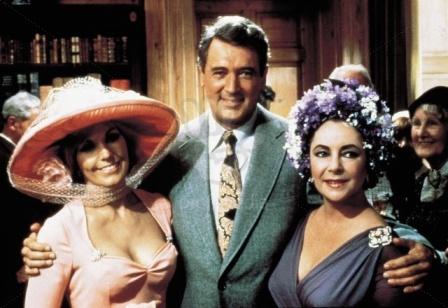 Rock Hudson, his theatrical appearances basically over at this time, turned to TV in his last five years before dying of AIDS in 1985. With much the same problem, Elizabeth Taylor here made her last starring role before she, too, turned to TV and began living on her past reputation and her perfume line.
Rock Hudson, his theatrical appearances basically over at this time, turned to TV in his last five years before dying of AIDS in 1985. With much the same problem, Elizabeth Taylor here made her last starring role before she, too, turned to TV and began living on her past reputation and her perfume line.
Kim Novak had generally retired from the movies, having made no real advance in her acting over the years, only as a screen ornament, especially luscious in Bell, Book and Candle (1958). As film scholar Leslie Halliwell wrote, this “artificially groomed American blonde . . . never managed to give a natural performance, though she did try.” Tony Curtis had reached his peak in the late ’50s with The Sweet Smell of Success (1957), Some Like It Hot (1959) and The Defiant Ones (1958), for which he was Oscar-nominated, along with co-star Sidney Poitier. All three films show Curtis’ versatility.
One of the highlights of The Mirror Crack’d is the squabbling between Taylor and Novak playing awfully close to reality as two has-been actresses working, if not together then in the same film within a film about Elizabeth I and Mary, Queen of Scots. (In one scene, Pierce Brosnan, fifteen years before his first turn as James Bond in GoldenEye [1995], has a silent part as Jamie.)
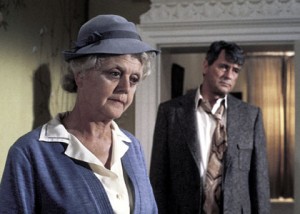 It’s 1953. A movie company has descended upon the unsophisticated but movie star mad little English village of St. Mary Mead, home of Agatha Christie’s amateur, busybody sleuth Miss Jane Marple (Angela Lansbury).
It’s 1953. A movie company has descended upon the unsophisticated but movie star mad little English village of St. Mary Mead, home of Agatha Christie’s amateur, busybody sleuth Miss Jane Marple (Angela Lansbury).
In the historical movie being filmed, Jason Rudd (Hudson) is directing his wife Marina (Taylor) who hopes for a comeback after a nervous breakdown following the birth of a retarded child. An old rival, Lola Brewster (Novak), arrives, much to Marina’s discomfort, to play the Scottish queen. Her husband Martin Fenn (Curtis) is the producer.
During a fête, which the English enjoy almost as much as ritual tea time, the movie people open Gossington Hall to the locals, highlighted by a near-catfight between the two actresses who exchange innuendos and barbed compliments. Marina to Lola: “What are you doing here so early, dear? I thought the plastic surgery seminar was in Switzerland.”
On a landing at the top of an elaborate staircase an effusive fan from Marina’s past, Heather Babcock (Maureen Bennett), reminisces about a time during World War II when she left her sickbed to meet her idol. As Heather babbles on, Marina is strangely transfixed and stares at a painting on a wall of the staircase. It’s a print of Giovanni Bellini’s Madonna and Child.
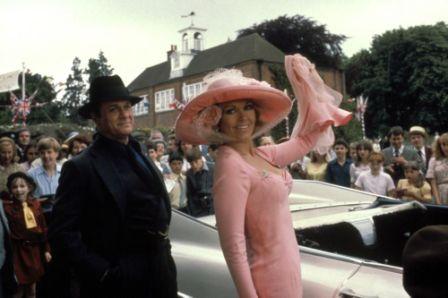 Marina passes to Babcock a cocktail made by husband Jason and the woman, minutes later, dies. At least this is what the camera indicates. In addition to this, Marina has been receiving anonymous death threats. Inspector Craddock (Edward Fox) believes the drink, which contained a barbiturate, was meant for Marina. The prime suspect appears to be Ella Zielinsky (Geraldine Chaplin, fourth child of Charlie Chaplin), who is secretly in love with Jason.
Marina passes to Babcock a cocktail made by husband Jason and the woman, minutes later, dies. At least this is what the camera indicates. In addition to this, Marina has been receiving anonymous death threats. Inspector Craddock (Edward Fox) believes the drink, which contained a barbiturate, was meant for Marina. The prime suspect appears to be Ella Zielinsky (Geraldine Chaplin, fourth child of Charlie Chaplin), who is secretly in love with Jason.
(For plot convenience or whatever, Inspector Craddock here becomes Miss Marple’s genial nephew and, appropriate to the script, a movie buff and Marina fan. In the Marple movies, as in the novels, Craddock is correctly unrelated—an annoyed but helpful Charles Tingwell in the four Margaret Rutherford movies [1961-1964] and an almost belligerent David Horovitch, as replacement Inspector Slack, in five of the twelve Joan Hickson BBC mysteries [1984-1992].)
Then when Ella is done in by a poisoned nasal spray, the remaining suspects are viewed in a different light: Miss Marple’s gossipy friend Mrs. Bantry (Margaret Courtenay), Doctor Haydock (Richard Pearson), the butler (Charles Gray), among others—and of course the three remainingHollywood interlopers.
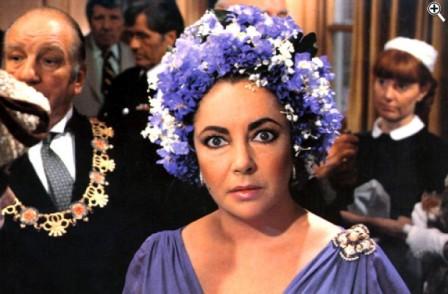 The solution comes to Miss Marple in the middle of the night. She sits bold upright in bed: “Of course!”
The solution comes to Miss Marple in the middle of the night. She sits bold upright in bed: “Of course!”
In flashbacks during the film, more information and clues are provided by eyewitnesses, mainly by Miss Marple’s maid, Cherry (Wendy Morgan), who saw what the camera didn’t earlier show. Miss Marple reveals in the denouncement at film’s end that Heather Babcock was telling Marinaabout leaving her sickbed and applying enough makeup to cover the telltale rash of German measles.
This plot device is frighteningly close—and a possible inspiration for Christie—to the experience of real actress Jean Tierney. For her also, an admirer still infectious with German measles had approached the then pregnant star, causing contagion and the birth of a mentally retarded daughter.
Miss Marple relates that after all these years, Marina, never knowing, learns from a total stranger how she contracted German measles. The star recovered enough to retire innocently to the bathroom, prepare a lethal cocktail, return to jog Babcock’s elbow enough to spill her drink, then graciously offer her drink.
But there is yet another death. Could it be . . .
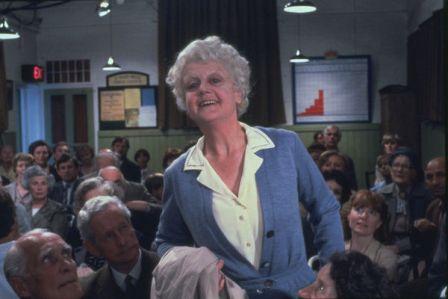 In a unique feature, even before the opening credits, The Mirror Crack’d begins with the showing at the village cinema of an old black and white movie, Murder at Midnight. Just when an Inspector Gates (Nigel Stock) is about to identify the murderer, the film breaks. The crowd speculates, but Miss Marple analytically eliminates first one suspect then another to reveal the true murderer.
In a unique feature, even before the opening credits, The Mirror Crack’d begins with the showing at the village cinema of an old black and white movie, Murder at Midnight. Just when an Inspector Gates (Nigel Stock) is about to identify the murderer, the film breaks. The crowd speculates, but Miss Marple analytically eliminates first one suspect then another to reveal the true murderer.
Murder at Midnight is not old, this scene not even part of a film but especially made to fit into this 1980 movie. To set the record straight, there is a film by this title, made in 1931, though with nothing to do with Agatha Christie.
Against a somewhat stilted and uninvolved Rock Hudson, an annoyingly bitchy Elizabeth Taylor and an overblown Kim Novak, Angela Lansbury triumphs. If there is a good reason to see the film, she provides it. Properly aged—the present nonagenarian was then only fifty-five—with grayed hair, a cane and a slight stoop, she gently underplays her part.
No mean feat. Including Rutherford and Hicks, Lansbury holds her own among other Miss Marple impersonators—Helen Hayes, June Whitfield, Gracie Fields, Geraldine McEwan and Julia McKenzie. Lansbury’s Miss Marple, with little change, became New England sleuth Jessica Fletcher in the twelve-season TV mystery series, Murder, She Wrote (1984-1996).
[embedyt] https://www.youtube.com/watch?v=9SYc_Uoa4VQ[/embedyt]